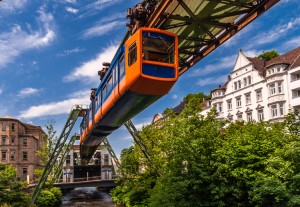Return of the Schwebebahn
August 21, 2019
Earlier this month, on August 1, the famous Schwebebahn electric suspension monorail reopened in Wuppertal, Germany. The oldest such train in the world—it began operating in 1901—the Wuppertal Suspension Railway (Wuppertaler Schwebebahn) had undergone nine months of repairs and renovations after part of its power distribution system failed in November 2018. The train’s reopening was celebrated with free ice cream and waffles for passengers, as well as a reawakened appreciation of the novel public transportation system.

On Aug. 1, 2019, the Schwebahn “floating railway” reopened in Wuppertal, Germany, after several months of renovation and repair. Credit: © Majonit/Shutterstock
The Schwebebahn (literally floating railway) carries 85,000 passengers a day an average of 39 feet (13 meters) above the ground along its 8-mile (13-kilometer), 30-minute route through the western German city of Wuppertal. The majority of the route follows the Wupper River, but when passing over busy city streets, the Schwebebahn floats serenely over traffic delays or winter snow drifts.
Aside from daily commuters, the photogenic Schwebebahn attracts tourists, artists, and selfie-takers. The monorail and its art nouveau stations and towers first appeared in cinema in the early 1900′s, and the train has since graced the background of a number of German and Dutch film scenes. In 1995, it starred in the British artist Darren Almond’s film, Schwebebahn, which showed an inverted trip aboard the train. The disorienting effect makes it appear as if the train were passing through an upside-down world.
The original plan for the Schwebebahn had it drawn by horses. This plan was then amended for the use of electric power. Construction began in the summer of 1898, and Kaiser Wilhelm II, the German Emperor, was one of the Schwebebahn’s first passengers on a trial run in October 1900. The train began operation in March 1901, and the full line was completed in June 1903.
The Schwebebahn has had an efficient and mostly safe history, but the train has had a few setbacks. In 1917, a derailment injured four people. During World War II (1939-1945), the train was largely destroyed, but it was rebuilt and reopened in 1946. In 1950, an ill-conceived circus promotion stuffed an elephant into a Schwebebahn car. The elephant, named Tuffi, panicked, burst from the car, and fell in the Wupper River (escaping unharmed but angry). In 1997, two cars collided, injuring several people, and in April 1999, the Schwebebahn’s only fatal accident occurred when a train car fell in the river, killing five people.
The recent Schwebebahn renovations were only the latest in a long history of expansions, improvements, modernizations, and train car replacements. The train (which has never changed locale) originally ran through the industrial cities of Barmen, Elberfeld, and Vohwinkel. These cities were combined with other communities in 1929 as Barmen-Elberfeld, which was renamed Wuppertal (Wupper Valley) in 1930.


